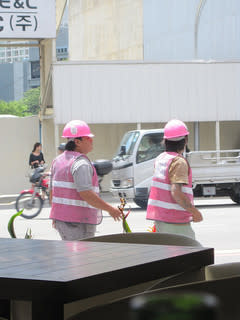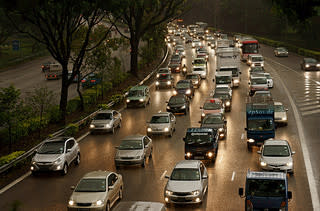6.9 Million People in Singapore: How Will It Affect You?
Heard the news? By 2030, there might be 6.9 million people in Singapore. It’d be inhumane to grow bacteria under conditions that cramped, let alone people. But no use dodging facts: Our immigration policies remain looser than a hooker’s pants, and we’ll be packed shoulder-to-shoulder in the coming years. Here’s our (strictly unofficial) take on how it’s likely to affect you:

Look, a rare native Singaporean. That one guy, in the far back.
What’s This About 6.9 Million Singaporeans?
A recent white paper, by the government’s panel of experts, estimates up to 6.9 million people in Singapore by 2030.
According to the current administration, this isn’t an intended goal but a worst case scenario. So you can relax. That means they’re doing what any rational person would do: Make drastic cut-backs to prevent the…oh wait. No. They’re just planning to accommodate 6.9 million people “if” the time comes.
To be clear: We don’t want it, we’re just seem to be preparing really hard for it.
That’ uh, kind like if you’re worried about being mugged, so you bring an extra $50 to accommodate whoever robs you. That said, there are some good and bad effects:
1. Great for Small Business Owners
I don’t charge by weight, not since we hit 6.9 million. Now get in line and bid for my lobster platter.
Here are the ways a bigger population can be bad for business:
That’s not a typo.
It won’t ever be bad for business, is what I’m saying. At the simplest level, bigger population = more potential customers. In addition, it means a bigger talent pool of employees, as well as access to cheaper employees.
Businesses that benefit most directly from a population surge are:
Retail
Food & Beverage
Anything Property Related
Financial Services
Some Forms of Private Education (Explained below)
Note: Benefits directly. Almost every other business will also benefit, just not as immediately as these.
Did I mention it even makes sales easier?
If a single neighbourhood clusters 50,000 residents, you can direct your marketing to all of them in one localized spot. It also means that small shops can count on heavier foot traffic, even in less mature estates. Overall, a good deal for small business owners.
2. We Can’t Afford NOT To Be Picky About Jobs

Worker? I’m a RESIDENT. My roof was done by budget construction.
When it comes to manual labour, which do you think big companies are more inclined to do:
Struggle to innovate new processes and raise productivity, in hopes of paying blue collar workers more whilst raising profit
Discover management has two brain cells between them, be unable to innovate, and instead raise profits by firing labourers and hiring cheaper ones
If you answered anything besides option 2, I suggest you seek a cure for this condition.
When it comes to blue collar jobs, few companies bother innovating. It’s easier to hire a cheaper janitor than to invent new ways of scrubbing floors.
That’s why NIKE uses Indonesian workers, and Apple assembles stuff in China: They don’t have to use pricey American labour, and then “innovate” to stay competitive.
With the presence of a bigger and cheaper labour pool, Singaporeans with replaceable skill sets (drivers, cleaners, loaders, etc.) will need to upgrade. It’s no longer about being picky, it’s about survival.
Nor is it entirely restricted to blue collar workers.
Over time, we’ll have better qualified non-locals. These will compete with us in fields like IT, finance, media, etc. So the bigger the population grows, the more we’ll need to build those skill sets.
3. Property Costs Will Rise
Oh wait. For $2 million you thought you’d be living INSIDE the actual building?
As population density increases, property values will rise. It’s a no-brainer.
The more people we have, the higher the collective demand for living space. And since foreigners can’t buy BTO flats, it means private properties and resale flats can only rise in value.
Don’t start celebrating yet. Remember that “rise in value” pretty much means “rise in cost”, for those of you who want to upgrade one day.
Overcrowding also bodes well for landlords: Some foreigners can’t afford a house in Singapore, not during their initial years here. As the numbers of this group will rise, landlords won’t need to worry about vacancies.
Landlords who cater to this new influx will be buying in non-central regions (If someone can’t afford a house, they can’t afford a luxury condo in District 9). Along with the development of estates like Punggol and Jurong West, the non-central regions will probably continue to see the biggest gains.
For more on these developments, follow us on Facebook.
Then there are the rich immigrants. They don’t have to rent, so they’re of no use to landlords. But they can afford to pay absurd prices, which means high capital gains for resale units. We may have to extend the SSD (Seller’s Stamp Duty), if house flipping becomes viable again.
Overall, a bigger population ensures a property peak higher than the last. I don’t know how the next cooling measure will work, short of the stamp duty involving human sacrifice.
4. Private Education Issues

“And we’ll ballot to see who’s homework gets marked, all 200 of you in my class.”
There are already complaints that Polytechnics, Universities, even neighbourhood schools, have too many foreigners.
There hasn’t been much response to this, beyond raised school fees for non-locals. But let’s put this in context: This is a country where people buy a house just to improve the odds of getting into certain schools. Parents get into actual fistfights over school placement.
Singaporeans not getting the schools they want is a powder keg. I don’t know who’s in charge, but that guy’s sitting on a live grenade with the pin pulled. Expect some upheaval, when non-locals start taking Singaporean places in our schools.
Also we barely have enough teachers now, let alone for a population spike. The probable teacher – student ratio in 2030 is likely to be 1 : Too Damn Many
And all this is why you’d do well to open a tuition centre.
Crammed schools mean students get limited attention, and will flock to private tuition or enrichment. At the tertiary level, students who can’t get into a University or Poly (due to lack of space) will probably turn to private colleges.
In particular, we may see a strong market for ESL (English as Second Language) courses. Some new arrivals might prefer low cost options, like conversational English classes at a Community Centre; so there’s some side-income potential there.
5. Transport Issues Will Get Worse
Lift? No thanks, I’ll walk. I’m in a hurry.
I don’t even have to go into detail on this, do I?
The MRT is more prone to breakdowns, buses are packed, and COE prices are insane. That’s right now, with a population of around 5 million. Take it to 6.9 million, and we’ll be super-gluing ourselves to the outside of train carriages for short trips.
At the very least, we can expect a serious review of the COE system. There’s no way we can keep bearing the cost of direct bidding. As more immigrants come in, competition for COEs will intensify. This is compounded by the fact that car numbers are capped lower than immigration.
And as for cab companies…they’ll be able to raise prices with impunity. So at the very least, start making some noise (at your workplace) about transport allowance.
Image Credits:
beggs, variationblogr, petrr, Denis Bocquet, elemenous, epSos.de
How do you think having 6.9 million people will affect us? Comment and let us know!
Get more Personal Finance tips and tricks on www.MoneySmart.sg
Click to Compare Singapore Home Loans, Car Insurance and Credit Cards on our other sites.
More From MoneySmart

 Yahoo Finance
Yahoo Finance 


